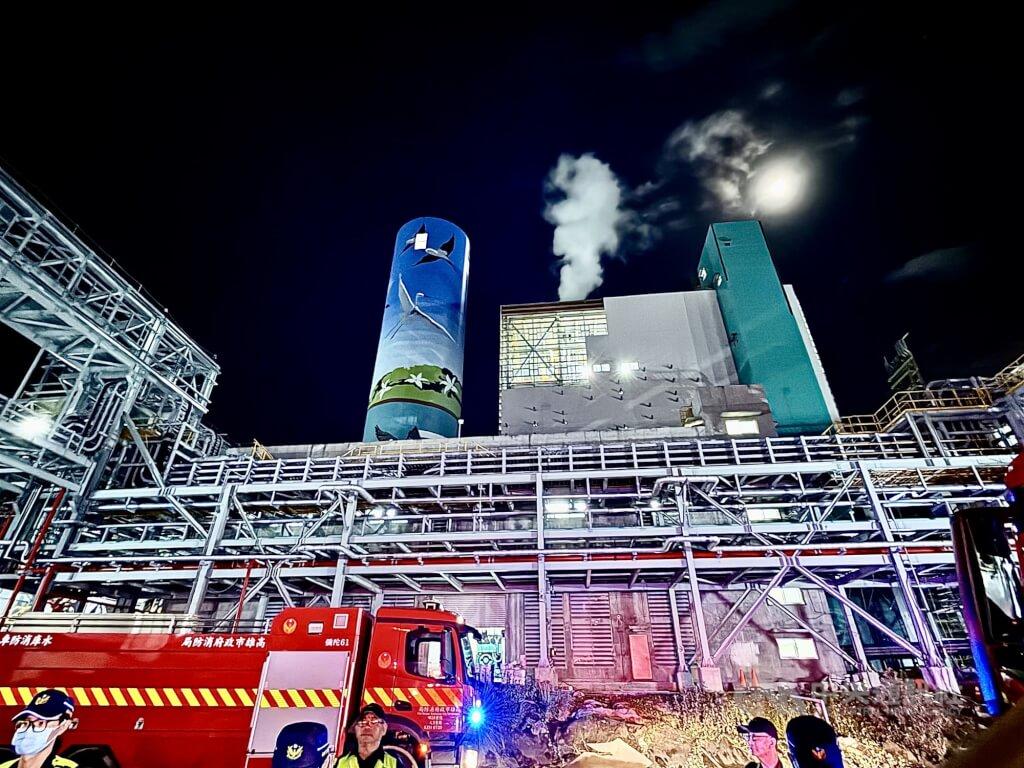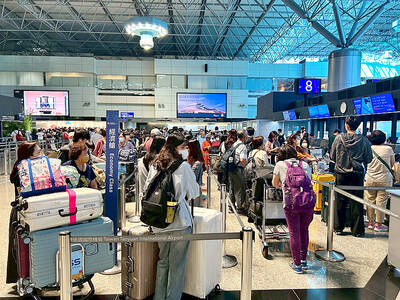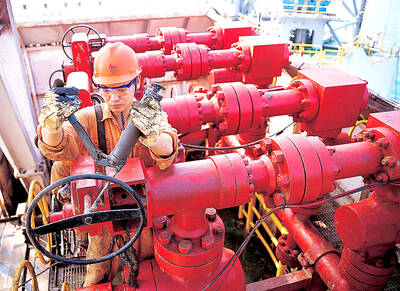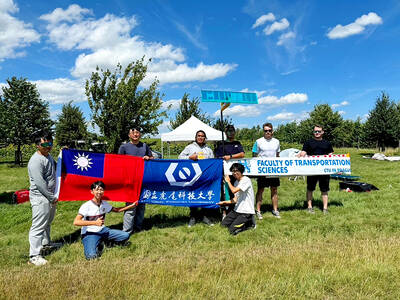A fire that broke out at Taiwan's third-largest power plant last night would not affect the nation's power supply, Minister of Economic Affairs Kung Ming-hsin (龔明鑫) said today.
The fire at the Hsinta Power Plant in Kaohsiung mainly affected its new natural gas Unit 2, which had been in a test operation phase, Kung told reporters.

Photo: CNA
Its 2-1 main body is unharmed and its 2-2 body is to be carefully inspected by Taiwan Power Co (Taipower) and its equipment provider, Kung added.
The plant's new natural gas Unit 1 was assessed to have no problems, Kung said.
To ensure an ample electricity supply, state-run Taipower does not rule out deploying backup units, he added.
Kung also apologized for the distress caused to residents.
Taipower said that preliminary assessments indicated that a gas leak in Unit 2 led to the fire.
The leak was detected at about 7:57pm, with the staff promptly stopping operations and reporting it, before the fire broke out at 8:05pm, Taipower said.
The Kaohsiung Fire Department arrived at 8:24pm and extinguished the fire, with no injuries reported.
The company pledged to investigate the cause of the leak and conduct comprehensive improvements to prevent similar incidents, as well as carry out inspections to see whether the damaged equipment needed replacement.
It added that it would regularly report on investigation updates and subsequent recovery matters.
Regarding concerns that the fire might have caused air pollution, Taipower said the Ministry of Environment and nearby air quality stations indicated there were no abnormalities.
The Hsinta Power Plant is a thermal power facility with the third-largest installed capacity in Taiwan.

The Chinese military has built landing bridge ships designed to expand its amphibious options for a potential assault on Taiwan, but their combat effectiveness is limited due to their high vulnerability, a defense expert said in an analysis published on Monday. Shen Ming-shih (沈明室), a research fellow at the Institute for National Defense and Security Research, said that the deployment of such vessels as part of the Chinese People’s Liberation Army (PLA) Navy’s East Sea Fleet signals a strong focus on Taiwan. However, the ships are highly vulnerable to precision strikes, which means they could be destroyed before they achieve their intended

About 4.2 million tourist arrivals were recorded in the first half of this year, a 10 percent increase from the same period last year, the Tourism Administration said yesterday. The growth continues to be consistent, with the fourth quarter of this year expected to be the peak in Taiwan, the agency said, adding that it plans to promote Taiwan overseas via partnerships and major events. From January to June, 9.14 million international departures were recorded from Taiwan, an 11 percent increase from the same period last year, with 3.3 million headed for Japan, 1.52 million for China and 832,962 to South Korea,

SOVEREIGNTY: The rigs show that Beijing ‘rejects Taiwan’s jurisdiction’ by building in areas where Taipei demands permission to build or alter installations Chinese oil rigs have been sighted just 26 nautical miles (42km), from Taiwan’s exclusive economic zone (EEZ) near Pratas Island (Dongsha Island, 東沙島), posing a threat to Taiwan’s sovereignty if left unchallenged, a brief published by the Jamestown Foundation on Tuesday said. Pratas Island, 444km from Kaohsiung, is northeast of the South China Sea and houses a Taiwanese garrison. The brief, titled “Rigging the Game: PRC Oil Structures Encroach on Taiwan’s Pratas Island” — referring to the People’s Republic of China — analyzed photographs and said that Beijing’s tools to pressure Taiwan now include oil rigs. “Oil rigs now constitute part of Beijing’s

The Taiwan Experience Education Program (TEEP) has funded short-term internships in Taiwan for more than 4,500 young people from more than 40 countries since 2015, with the goal of attracting and retaining international talent, the Ministry of Education said yesterday. Fifty-five colleges launched 514 projects this year, including in fields such as semiconductors, artificial intelligence, medicine and biotechnology, green energy, and sustainability, it said. The program provides research and practical internships in Taiwan for two to six months, and offers cultural exchange and networking opportunities, the ministry said. For example, National Formosa University’s Embedded System and Autopilot Laboratory developed two solar-powered drones in